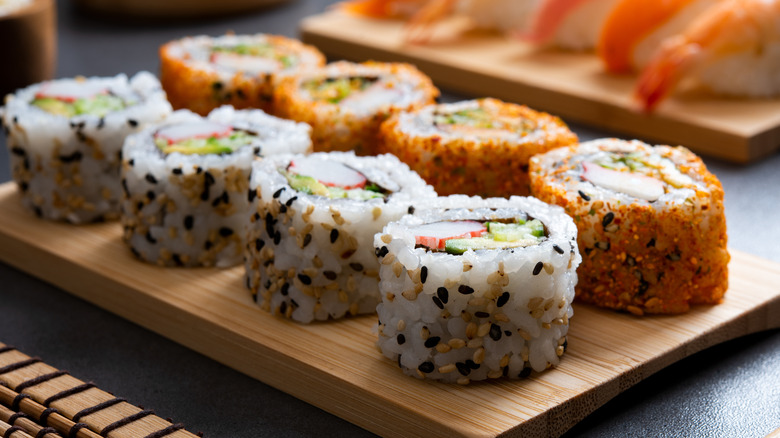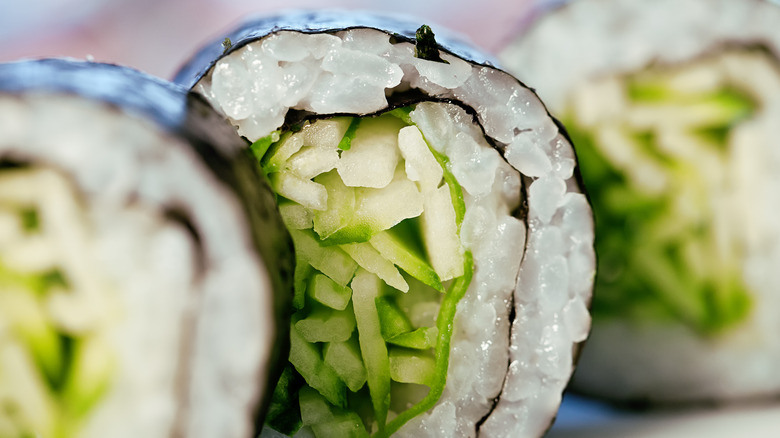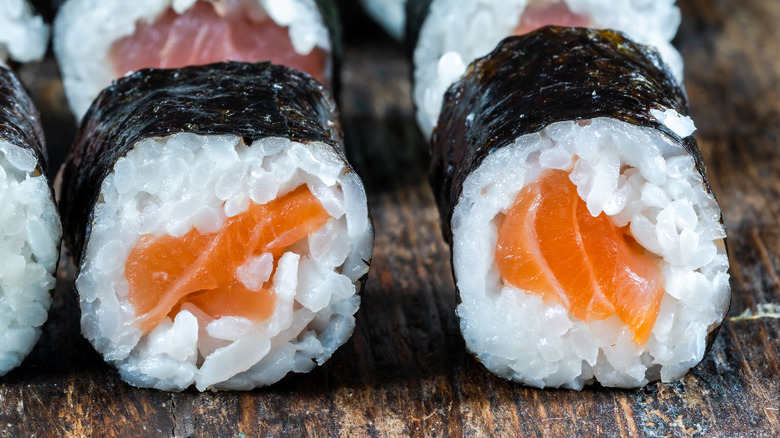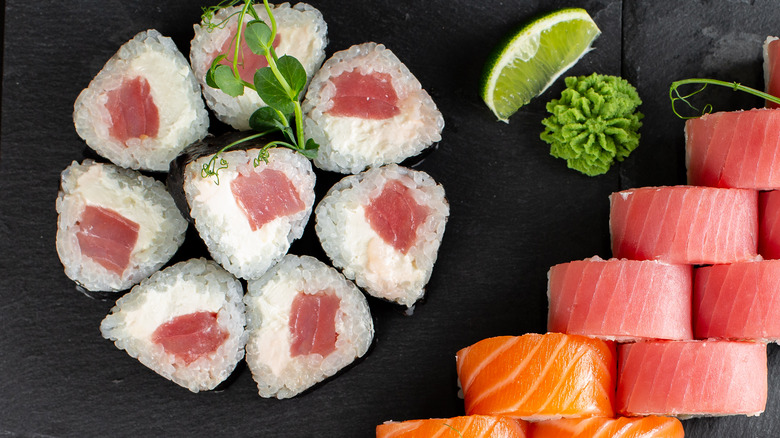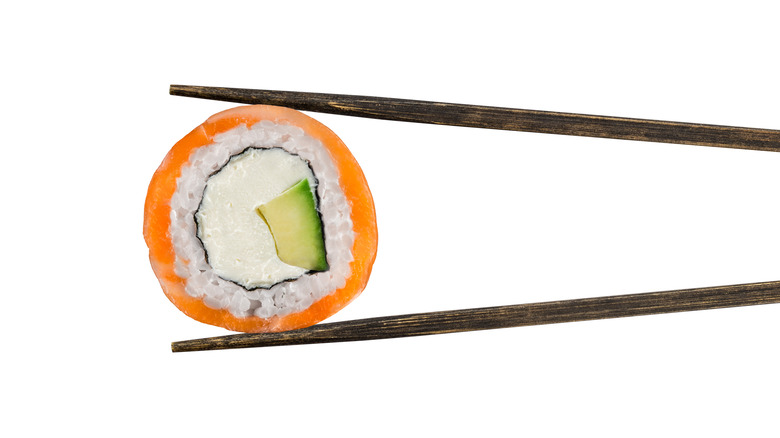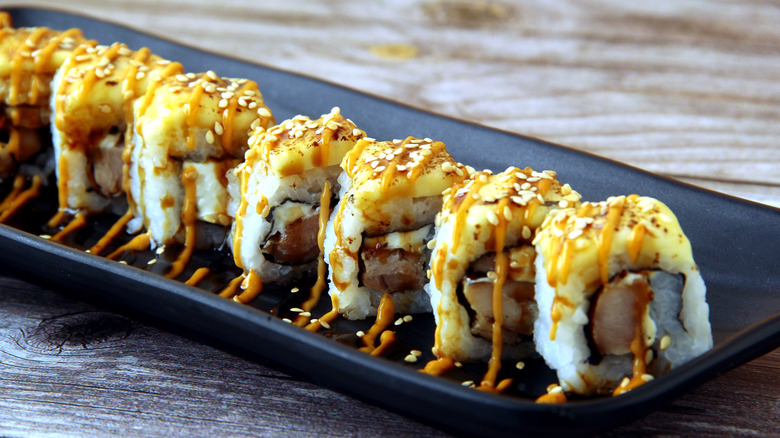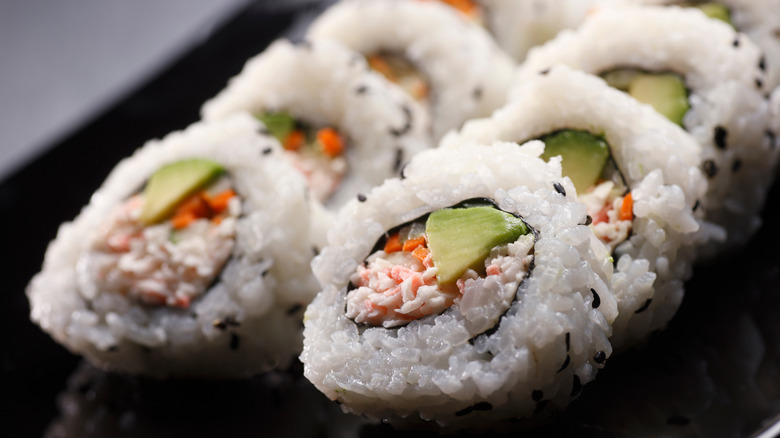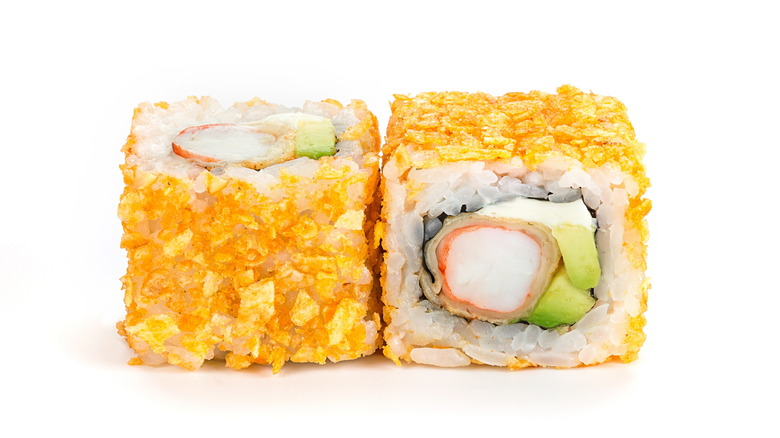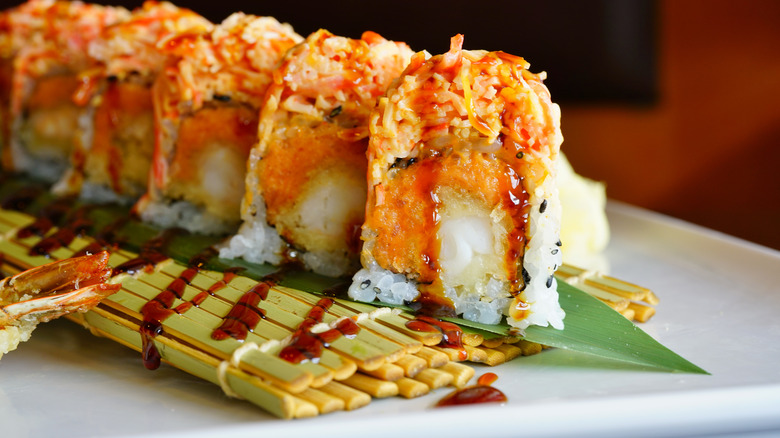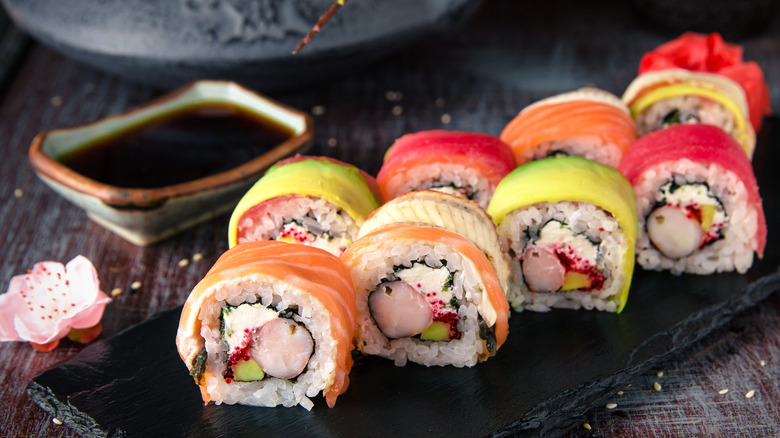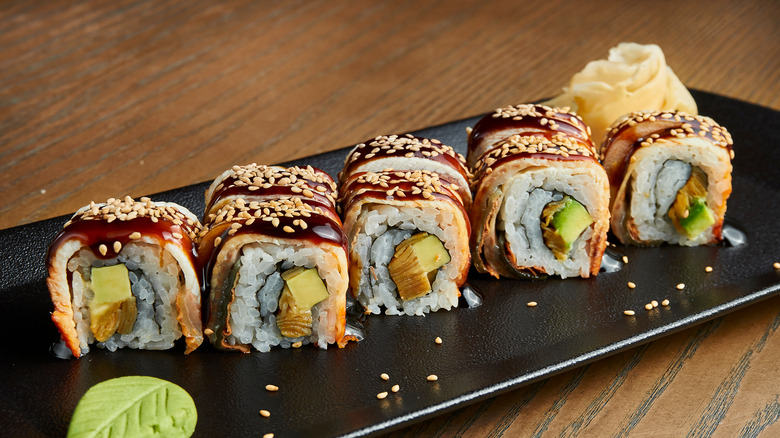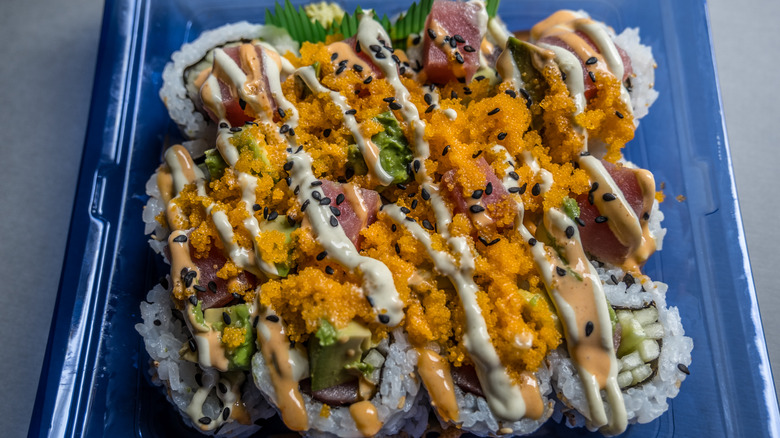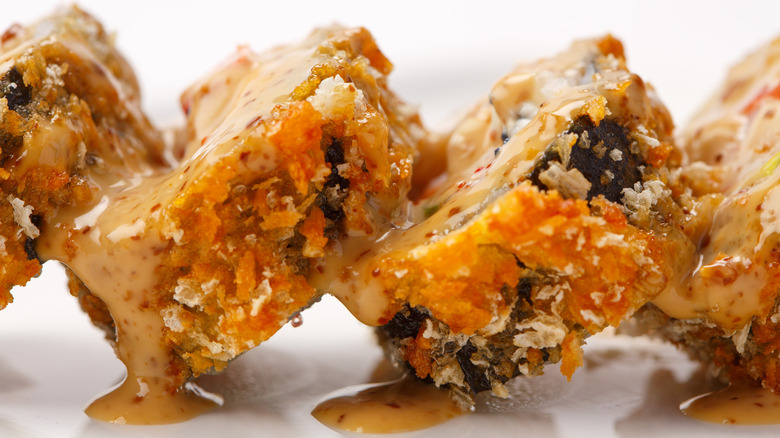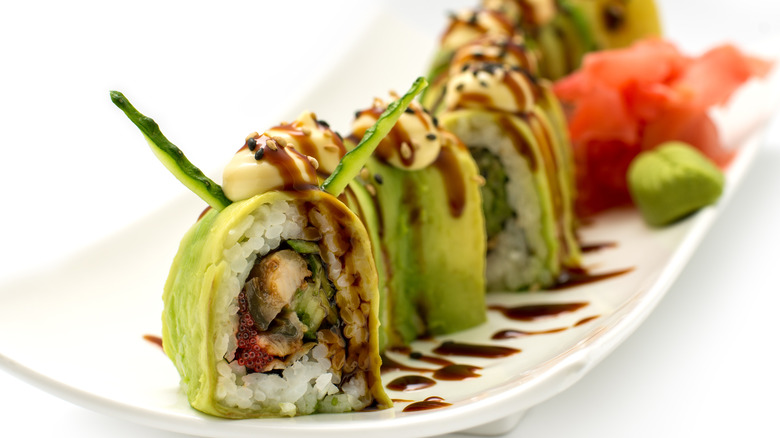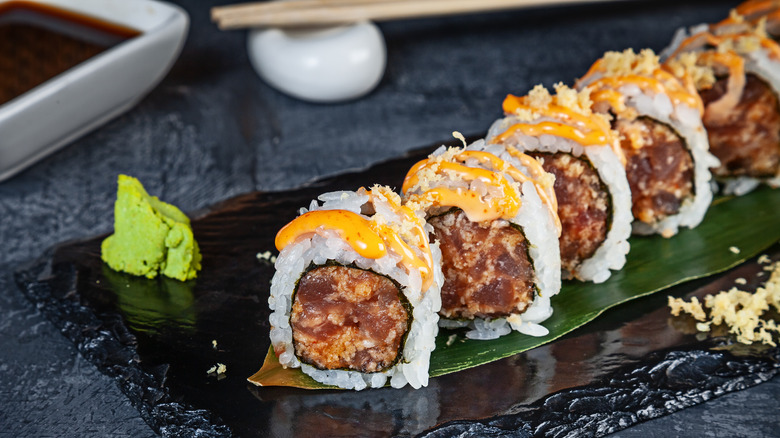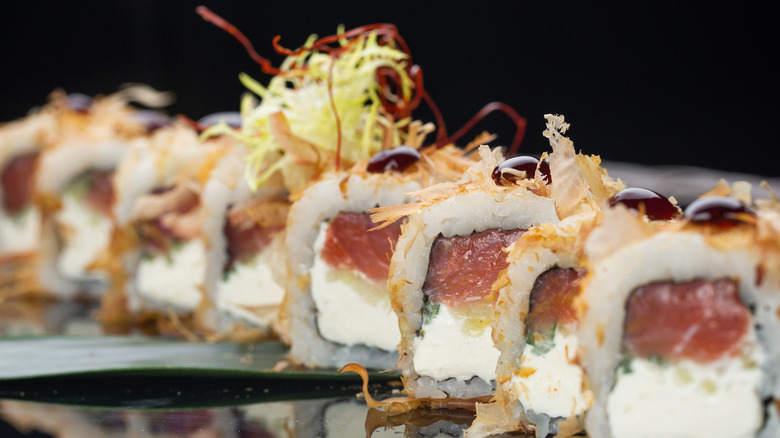15 Popular Sushi Rolls Ranked Worst To Best
All sushi is good sushi. Raw sushi, cooked sushi, vegetarian sushi, it really doesn't matter. Add a little wasabi and some soy sauce, wash it all down with a piece of pickled ginger and it's all delicious. But, we humans are a species that likes things to be arranged in neat and tidy lists for easy reference, so even though all sushi is good, it, like all other things, must be ranked according to relative goodness.
It's not easy to rank something from worst to best when it's all delicious, so we made a couple of basic ground rules, which (much like pirate code) are really more like guidelines. There's flavor, obviously. But there are other factors, too, like how complex is the flavor? And how sushi is it? Because you can wrap up Texas-style barbecue chicken in rice and nori and call it sushi, but it's not really sushi.
On the other hand, American-style sushi is pretty different from traditional Japanese sushi. Japanese sushi is simpler — just fish and rice without all the bling — so we have swayed this list more towards what you'll find in an American sushi restaurant. But we also ranked certain rolls lower if they are heavy on weird ingredients, though we've also given some leeway to rolls that aren't super traditional and yet have become mainstays of American sushi. With that said, here's our take on what's great and what's less great on the menu at your local sushi place.
15. Cucumber roll
There are a couple of problems with the lowly cucumber roll. First, it's just hard to call it "sushi" if it doesn't feature seafood. In its earliest form, sushi was a fish-based dish, and as it evolved, fish continued to form the basis of the cuisine no matter where you found it. Now granted, sushi has changed an awful lot since its origins, and traditional sushi doesn't contain things like avocado or spicy sauce or deep fried anything, either, but it almost always contains some sort of seafood.
It's our opinion, to be sure, but we think a sushi roll that has no ties to the sea just isn't sushi enough, and that's why the cucumber roll gets to be "the worst" sushi roll on our list. To be fair, though, it's nothing against cucumbers — it's just that vegetarian sushi of any kind is really just plants dressed up like sushi so people who don't eat fish can still pretend like they're eating sushi. It's just not in the same category as what we personally think of as "real" sushi.
Having said all that, cucumber rolls can still be delicious, and there is no reason you should avoid sushi all together just because you don't happen to like fish. We just think the cucumber roll isn't in the same category as the other rolls on this list.
14. Salmon roll
The salmon roll is a simple, basic introduction to raw fish sushi. A lot of people who were once put off by the idea of eating the raw fish may eventually be enticed into eating a salmon roll, mostly because it just seems less scary than some of the other things you can get at a sushi restaurant. The salmon wrapped up inside a salmon roll looks similar to a piece of smoked salmon, which may be more familiar to some Americans (although it's worth remembering that cold-smoked salmon is essentially raw, though you probably don't think of it that way.) Either way, smoked salmon is something you might have eaten before, whether on an hors d'oeuvre or on a bagel, which might make it easier to cross over to eating it in a sushi roll.
A salmon roll is also a friendlier choice than salmon nigiri, because it's a small bite, it's got a good balance between fish and rice, and it just doesn't look as intimidating. Plus, if you're hoping for a more traditional experience, a salmon roll comes closer than something like a California roll — it's just rice and fish, and if you go easy on the wasabi and soy sauce it's a great way to enjoy the mild flavor of uncooked salmon.
On the other hand, it's a bit boring. We ranked the salmon roll low not because it isn't a decent offering but mostly because it's just not that interesting.
13. Tuna roll
The tuna roll ranks low for many of the same reasons as the salmon roll — it's basically the same roll but with a different piece of fish. However, we find tuna to be a bit more flavorful than salmon, and tuna is also kind of a mainstay of American sushi. If you can't eat a tuna roll, you should probably just order the teriyaki chicken because sushi clearly just isn't for you.
Tuna is a little scarier for the uninitiated than salmon because of its bright red color and the fact that it doesn't really resemble anything you've ever eaten before. In roll form, the tuna tends to be a little less front and center, so as a plus it'll probably be a lot easier for a newbie to bite into than, say, the big hunk of tuna you'd get on a piece of nigiri. For the rest of us, though, an ordinary tuna roll is just not a very exciting or interesting roll, and that's why it gets such a humble ranking.
12. Philadelphia roll
Let's just preface this by saying that the Philadelphia roll does taste good. But we just couldn't bring ourselves to rank it very high on the list because it wanders a bit too far off course as far as what we think truly qualifies as sushi. It's definitely a good choice for someone who has never had sushi or fears those big chunks of raw fish, and it's also a good choice for someone who likes bagels, but it's just a little too, well, weird to join the likes of the dragon roll or the spicy tuna roll as an important part of the sushi experience.
That's because the Philadelphia roll is basically just a bagel and lox wrapped up in rice and nori, only without the bagel. It features smoked salmon and cream cheese, so it might give you some flashbacks to a Jewish deli in New York City, although the addition of cucumber or avocado may temper that experience somewhat.
Smoked salmon and cream cheese are a delicious combination but we still think it's kind of a weird thing to put in sushi, especially since the typical Philadelphia roll is more cream cheese than anything else. That's why we can't really recommend it over any of the other much more inspired rolls on this list.
11. Teriyaki roll
Similarly, a teriyaki roll is sort of designed for people who fear raw fish but would still like to eat sushi. Frankly, we feel like this is an oxymoron — if you don't want to eat raw fish then no amount of chopping and changing the ingredients is going to turn something that's not sushi into sushi.
Still, the teriyaki roll is okay in its own way. Replace the teriyaki chicken with any fish and it would be a pretty decent, standard sushi roll. Depending on the restaurant, a teriyaki roll may include some cucumber sticks and a topping of avocado and sesame seeds, so it's not like it's just a piece of chicken rolled up in rice and nori. Besides the fact that it's chicken, the other thing that doesn't work so well is the strong teriyaki flavor. When you combine this roll with wasabi and soy, you get a lot of really strong flavors competing with each other and it tends to be a bit overwhelming. So if you do order the teriyaki roll, you may want to eat it bare, without the addition of all the traditional condiments.
10. California roll
The California roll is in the same camp as the other non-raw rolls on this list, but it gets a higher ranking just because it has become such a mainstay of the sushi experience no matter where you go in America. In fact, DoorDash says it's the most popular sushi roll in America, at least according to whatever DoorDash's metrics are (via Bustle).
The California roll, like the teriyaki roll and the cucumber roll, was designed for the raw-fish averse. It was really kind of a genius invention, because any restaurant that serves only raw fish limits their customer base, especially in raw-fish averse America. Anyway, today the California roll has become such a popular roll that it would be unfair of us to not give it a little boost on our list of worst to best.
In case you are one of the six people left in America who is unfamiliar, the California roll features a filling of cooked crab meat (usually imitation) with avocado, which makes it a pretty safe choice for a newbie. The California roll may look slightly different depending on where you order it — sometimes it's made with shrimp instead of crab, sometimes the filling is crab salad rather than solid chunks of crab, and sometimes the chef adds a few carrot matchsticks. It may also be topped with sesame seeds or even tobiko (flying fish roe), the latter of which makes it slightly less friendly for the uninitiated.
9. Shrimp tempura roll
Also called a tiger roll (for the tiger shrimp it's made with), a shrimp tempura roll is kind of just a California roll with a little extra bling. The shrimp inside a shrimp tempura roll is battered and deep-fried, and it sometimes gets a little extra crunch from the addition of cucumbers. Like a California roll, this roll includes avocado and depending on where you get it, it may also be topped with tobiko. We have also seen shrimp tempura rolls with a crunchy, deep-fried exterior.
The shrimp tempura roll is a little more inspired than a California roll, which is why it gets to be higher on the list. But it's yet another example of sushi that's only marginally sushi because it's nice and safe and cooked. It's also a little less healthy for you than a California roll given that the shrimp is deep fried, so while that does give it some extra flavor and a nice crunch, it's not great if you're counting calories.
8. Spider roll
A spider roll is basically a shrimp tempura roll, only with crab tempura instead of shrimp. It gets elevated a bit with the addition of some spicy mayonnaise — sure, spicy mayonnaise isn't really traditional, but mayo has been popular in Japan since at least the 1920s, when Toichiro Nakashima discovered mayonnaise in America and brought it back to Japan. Most Japanese restaurants use Japanese mayo to create the spicy topping you'll find on a spider roll and several other popular sushi rolls.
Like most of these other rolls, all restaurants do a slightly different take on the spider roll, and you may find versions that also include cucumber or avocado, sometimes both. The spider roll is a safe bet if you don't want to eat something raw but you still want to experience some of the different flavors featured in other rolls. It lands ahead of the shrimp tempura roll mostly because the spicy sauce gives it a more complex and interesting flavor than the somewhat blander shrimp tempura roll.
7. Rainbow roll
The rainbow roll is what you branch out to when you've had too many California rolls and you think you might be ready to try something a little more daring. This is essentially a California roll on the inside with a much more daring exterior.
Inside the rainbow roll you'll find the familiar crab and avocado combo that made the California roll famous. Some restaurants add some cucumber to give the roll a little more crunch, and you'll occasionally find cream cheese in there, too. The name "rainbow” comes from what's on the outside of this roll — it's topped with slices of raw salmon, raw tuna, and avocado. This gives it great visual appeal and some of the raw fish experience alongside the familiarity and safety of a California roll. Think of it as training wheels for new sushi-eaters.
We like the rainbow roll not just because it looks beautiful on the plate but because it provides some complexity — you get that mild, raw-fish taste with the slightly stronger flavor of the crab, and the subtle earthiness of the avocado. If you're lucky, your chef might sneak a hunk of wasabi under the raw fish, which will give you a nice little kick in your nose to finish the rainbow roll experience.
6. Unagi roll
The unagi roll is, for many people, a conundrum. Unagi is basically eel, and when you think of eel you probably think of something long, ugly, and sort of worm-like that is capable of delivering an electric shock if you get too close to it (note that most eels don't do this, but we don't blame you if that's what immediately comes to mind). Anyway, Americans tend to be averse to the idea of eating eel, so the fact that it's cooked eel may not really make it seem more appealing to you, depending on which end of the "ew" scale you think an eel is.
Still, unagi is pretty delicious. An unagi roll features a small piece of cooked, freshwater eel coated in a thickened, sweet soy sauce. There are a lot of variations of the unagi roll — some include nothing but unagi while others are married with a piece of avocado. Some have got the unagi on top with avocado and shrimp or crab in the middle. Sometimes, an unagi roll is just an unagi-topped California roll. Either way, it's the unagi sauce that really makes this roll. The best ones come with streaks of sauce on top with a little extra on the plate for dipping.
5. Hawaiian roll
The Hawaiian roll shares its name with those unnaturally sweet bread rolls in the orange package that some people like to serve around Thanksgiving, but that's where the similarities end. The sushi version of a Hawaiian roll is neither sweet or, you know, bread, and it's kind of also an edible work of art.
The Hawaiian roll, like most other sushi rolls, is different depending on where you order it. For the most part, it's an elaborate and beautiful presentation featuring shrimp tempura, spicy crab, and cucumber. Some restaurants add tuna and avocado to the outside of this roll, giving it a look that resembles a rainbow roll. Other restaurants really embrace the whole Hawaiian thing by adding a little piece of mango (um, no thanks). These rolls are usually topped with crunchy tempura, sesame seeds, or tobiko (sometimes a combination of all three). Even though they're often also suitable for the sushi noob (as long as you don't order the rainbow roll style), we think they're complex and delicious and deserving of a high position on our list.
4. Golden roll
Golden rolls also tend to differ a bit from restaurant to restaurant, but in general they're sort of a jack of all fish, featuring a combination of salmon and tuna with echoes of California roll — there's crab and avocado in there too. The common denominator for all golden rolls is a crunchy something-or-other on the outside, whether it's a crunchy tempura topping or Panko breadcrumbs. Sometimes the whole golden roll has been deep-fried, so it's got a crunchy coating all the way around.
Most of these fancier rolls are a long way from the simple combination of rice and fish that you find in traditional Japanese sushi, but the golden roll is even more so as it's often served with a sweet sauce. Not every restaurant has the same recipe, but the sauce is usually made from some variation of unagi sauce, though you also find some versions that are served with a sweet chili sauce or spicy mayo. Either way, there's a lot happening in a golden roll, and we think it deserves high praise no matter where you order it.
3. Dragon roll
The dragon roll is so-named because the presentation resembles a dragon. Not like a Targaryen dragon (though frankly that would make for some super-interesting sushi), but the long, snake-like dragons you've probably seen in Japanese art. A dragon roll is really a work of art before it is an entree — we've seen dragon rolls laid out in twists and turns like their namesake, with a shrimp tail at the end to give them an extra-dragony appearance. Some dragon rolls even have faces like dragons, but they all have something on the outside that's meant to look like dragon scales, whether it's thinly sliced avocado or some type of fish.
Inside this sushi roll is a combination of Unagi, cucumber, and crab (usually imitation, sometimes real). Most dragon rolls feature cooked ingredients, though there are some versions that include tuna. Others are topped with tobiko, so this isn't a total noob roll though it is friendlier than the average piece of nigiri. You might also see this on a menu as a caterpillar roll — it still looks more or less the same but is named after a somewhat less appetizing animal.
2. Spicy tuna roll
You may feel like we're going a bit backward by placing the spicy tuna roll way up high on our list. After all, a spicy tuna roll is basically just a tuna roll with the addition of a spicy sauce. Still, we love the spicy sauce so much that we don't really care if our assessment is out of line with the typical sushi eater. The spicy tuna roll may not have the curb appeal of a rainbow roll or the crunch of a golden roll or the artistry of a dragon roll, but dang, it tastes good.
Depending on where you order your spicy tuna roll it may simply have a spicy tuna filling or it may also be topped with lovely, spicy sriracha mayo. We have also seen it made with avocado and sprinkled with tobiko. Pretty much every incarnation of this roll is delicious, and we don't personally visit any sushi restaurant without getting at least one order of this mainstay.
1. Firecracker roll
Yeah, we dissed the Philadelphia roll because it had cream cheese in it, and the firecracker roll has cream cheese too. The difference between the two — and the reason why the firecracker roll is way up on the list while the Philadelphia roll is closer to the bottom — is because the cream cheese isn't the star, it's simply a complement to a lot of other delicious ingredients. The firecracker roll is in first place on our list not because it's an especially traditional sushi roll, but because flavor wins the day.
The firecracker roll has tuna as its main protein but it is sometimes also topped with fried salmon. This roll is finished with a spicy sauce – sometimes it's a combination of mayo and Unagi sauce, and sometimes it's a spicy sriracha mayo sauce. Either way, this is a complex roll with a few traditional ingredients and a little bit of American flare. The bottom line is that it's really flavorful, beautifully presented, with all the qualities that you want in a fancy sushi roll: the mild taste of uncooked fish, a crunchy exterior, and a little bit of spicy kick. If you can try only one sushi roll, this should definitely be the one.
